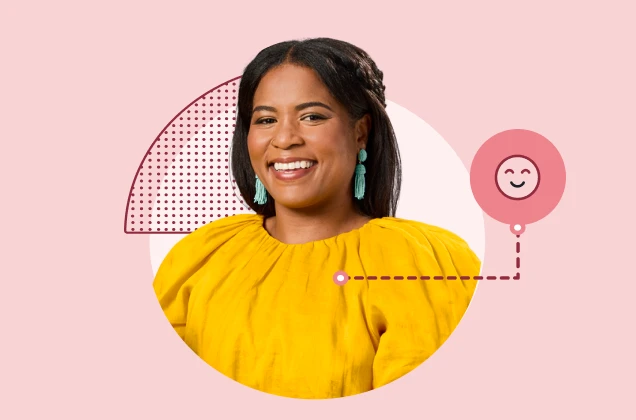Branding and building brand identity
Track the performance of your brand and see how it evolves over time.
Why do consumers choose your company’s products or services over the competition? Chances are your brand plays a big role in their decisions. And how you go about branding your company and developing and promoting your brand identity can go a long way toward keeping those customers and consistently attracting new ones. Understanding the difference between branding and brand identity—and how to make the most of each can help you build on your success and stay true to your customers.
What is branding and brand identity?
The terms branding and brand identity are certainly related, but they are not synonymous. Branding refers to the marketing practice and activities that go into consistently shaping and promoting a distinctive brand. Meanwhile, many of those branding activities are built on what is known as brand identity. Learn more about brand image and how to measure it.
Brand identity is the collection of all elements, such as logos, visual imagery, and key messaging that a company creates to portray the right image to its consumer. A strong brand identity can help build trust, loyalty, and a sense of familiarity among your target audience.
Fuel your brand strategy with insights
Use consumer trends and research to monitor competitive threats, manage your brand reputation, and more.
Examples of strong brand identity
You’re likely familiar with many of the companies that have had success building a brand identity. They have done what it takes to create a brand that is highly recognizable, and has built a loyal customer base.
Coca-Cola has built an iconic brand with a well-known logo and ribbon-like imagery on its cans. The company employs red on its Coke products, and a font that conveys enjoyment, and a uniquely shaped bottle that assures customers that they are getting “the real thing.”
Burt’s Bees has built their brand by creating a familiar and homespun feel to how they portray their company and products. Their logo depicts their bearded founder, emphasizing the human connection and feeling of simplicity offering a stark contrast to more flashy and corporate competitors in the personal care space. They back that imagery up with emphasizing their love of nature by responsibly souring products, using recycled packaging, and giving to a range of green initiatives.
Why is brand identity important?
Building a strong brand identity is essential to generating loyalty and trust among your customers, and continuously attracting new ones as well. Ultimately the most successful brand identities create an emotional connection with customers, many of whom become fiercely loyal and outspoken advocates for your brand and products. Among the key factors that are furthered by a strong brand identity are:
Credibility and trust
Writer and consultant Fred Fred Reichheld might have said it best: “Without trust, there can be no loyalty—and without loyalty, there can be no true growth.”
Building trust and credibility is essential to the success of your company and it can be strengthened and affirmed through a strong and consistent brand identity that builds over time. Of course, the foundation of that trust and credibility is through knowing your stuff and meeting and exceeding your customer’s expectations. Your brand identity can amplify those traits through clear and consistent branding of images and messages.
Advertising impressions
You can build the world’s best brand identity, but if you can’t successfully share it with the world it does you little good. That’s why it is essential to promote your brand through a range of marketing and advertising efforts.
Of course, the key is to cut through the clutter—experts estimate that the average person encounters between 6,000 to 10,000 ads every single day. To capture attention—and consistently score impressions – it’s important to portray your brand identity in ways that are both simple and compelling. You want to distinguish your brand from competitors while building familiarity and trust with your customers and potential prospects. Delivering your brand identity consistently over multiple channels frequented by your target audience can help build strong affinity and loyalty over time.
Creating new customers and nurturing existing ones
A strong brand identity that portrays your company’s strengths, values, and differentiating quality can attract people who agree with what your brand has to offer. Once you have captured the interest of a potential prospect, a strong and consistent brand identity can lead them to become customers. Additionally, once these people become customers, that same brand identity should do the work of nurturing the relationship further by resonating with the customer, aligning with their values, meeting their needs, and providing a sense of belonging and affinity with your company and other customers.
How to build a strong brand identity
In some ways, building a strong brand identity is akin to constructing a sturdy house. You need to get a solid foundation in place, and then take the steps necessary to add all the elements and features to create a finished product that will be a stable and comfortable home for potential buyers. With that in mind, here are a few key steps to building a strong brand identity.
- Conduct a brand audit
Before you can determine where you are going with refining and promoting your brand identity, you need to get a clear picture of where you are right now. The most effective way to achieve that is by conducting a brand audit that provides considerable insight into how your brand is positioned and perceived.
This brand audit screening survey offers an example of how to gauge your customers' current awareness and perceptions of your brand.
- Establish a value proposition and mission statement
A brand's value proposition captures the most compelling and unique aspect of what you offer to your customers. Ideally, this value proposition should not only quickly and clearly convey valuable benefits to your customers but also highlight what sets you apart from your competitors. Meanwhile a mission statement should capture the core essence of what your organization strives to achieve, offering a north star for employees and a clear sense of what your company stands for to customers and prospects. Both your value proposition and mission statement should be top of mind as you define and build your brand identity.
- Create strategies for establishing your brand identity
Once you have a clear sense of current perceptions and differentiators of your brand and the key elements that form your brand identity, you can then strategize on how to strengthen and promote your brand identity.
The foundation of your strategies should be making sure that your brand image is consistent across all your channels and communications and then finding authentic ways to get your message out to your target audience. Be sure to emphasize your value proposition as well as elements of your brand that differentiate from your competitors.
Finally, don’t look for quick fixes or gimmicky approaches. Today’s consumers are savvy and can sense when a company is cutting corners or exaggerating claims. Building a strong brand identity takes focus and time.
- Analyze and refine
Solidifying and promoting your brand identity is an ongoing process that requires proper care and feeding. Make sure to establish a process for continually analyzing and assessing how your brand is being presented and perceived. While the core of your brand identity should remain the same changes in the market, emerging trends and evolving consumer preferences and attitudes might require you refine your brand identity strategies to keep current with the times, and a step ahead of the competition.
Brand power
You can build the power of your brand as consumers more readily recognize your cHow do you get consumers to recognize you—and to recommend your product or service to others? Through helping people conduct market research every day, we’ve learned a lot about how to improve the strength of your brand identity (especially through surveys).
How brand power is measured
Is your brand on consumers’ minds when they’re looking to make a purchase? When you know how visible (or invisible) you are to consumers, you’ll understand how strong your brand is in your market segment, and whether you need to tailor your marketing efforts accordingly. Ask survey questions that test for brand recall—your consumers’ ability to name your brand on their own to see if they’re thinking about you (or your competitors) first.
For example, ask an open-ended question like, “When you think of online streaming video services, what brands come to mind?”
To measure brand recognition, which is consumers’ ability to recognize your brand among a list of the others in your category, ask a closed-ended question like, “Which of the following brands have you heard of? (Select all that apply.)” Make sure that in the list of answer choices, you include your brand name along with the names of other big brands.
Improve your brand power
Through consistent measurement you can take steps to improve your brand power over time. You can do this by identifying gaps in awareness or perception of your brand and then targeting marketing and advertising efforts to fill those gaps. Additionally feedback via surveys and continuous measurement can help provide direction on elements of your brand you might want to emphasize—or those that you could downplay.
Types of brand surveys
There are a range of different types of brand surveys all of which can be deployed to help build a better brand identity or increase awareness or understanding of your brand. These surveys include:
Brand perception surveys
Brand perception surveys are aimed at capturing insights about respondents' awareness and perception of a particular brand. They are typically brief surveys that include an option to include more in-depth feedback.
Examples of brand perception survey questions include:
- How familiar are you with this brand?
- How would you describe your overall opinion of the brand?
- How likely are you to purchase a product from this brand?
Brand positioning surveys
Brand positioning surveys help you determine the best way to position your brand compared to others in your space. Brand positioning should maximize your value proposition as well as your company’s values, mission, and differentiating factors.
Examples of brand positioning survey questions include:
- Which of the brands listed below are you familiar with?
- What do you like most about the brand you are most familiar with of the brands listed below?
Brand awareness surveys
Brand awareness surveys aim to measure respondents' level of knowledge about your products and services and how your brand recognition compares to competing brands in your category. Gaining insight into awareness levels can help direct your branding and marketing efforts.
Examples of brand awareness survey questions include:
- When was the last time you used this product category?
- When you think of this product type, what brands come to mind?
Try our brand awareness survey template
Brand identity surveys
Brand identity surveys are focused on helping you further define your unique identity by identifying your strengths and value proposition and comparing it to others within your category.
Brand identity surveys can be used for your internal audiences to help gain a better understanding of your key differentiators and where you fit in the competitive market.
Examples of brand identity survey questions include:
- Who is our competition? How do we fit into the competitive landscape?
- What is our current brand personality?
- Should our new logo be revolutionary or evolutionary?
How to improve your branding and brand identity
There are several ways to enhance your branding and improve brand identity, including:
Measure brand awareness and Recognition
Is your brand on consumers’ minds when they’re looking to make a purchase? When you know how visible (or invisible) you are to consumers, you’ll understand how strong your brand is in your market segment, and whether you need to tailor your marketing efforts accordingly. Ask survey questions that test for brand recall—your consumers’ ability to name your brand on their own to see if they’re thinking about you (or your competitors) first.
For example, ask an open-ended question like, “When you think of online streaming video services, what brands come to mind?”
To measure brand recognition, which is consumers’ ability to recognize your brand among a list of the others in your category, ask a closed-ended question like, “Which of the following brands have you heard of? (Select all that apply.)” Make sure that in the list of answer choices, you include your brand name along with the names of other big brands.
Determine your brand attributes
It’s one thing for consumers to be aware of your brand—but knowing what they think of your brand category (or which brand attributes or characteristics they associate with it) is just as important. If your market is bottled water, for example, what brands within that category come to mind for most people? And what are the good, bad, and even ugly traits that people associate with bottled water?
When you know the answers to these questions, you can shape your brand image to combat negative attributes and play up the positive ones. Start gathering these details by asking questions about your brand category—and via asking people to assign characteristics to your brand.
Understand customer loyalty
When your customers have the opportunity to go with another brand and they continue to choose yours—well, that’s brand loyalty. A great way to measure customer loyalty is to use the Net Promoter® Score (NPS), the standard companies around the world use to see if customers are recommending them to others.
Net Promoter, Net Promoter Score, and NPS are trademarks of Satmetrix Systems, Inc., Bain & Company, Inc., and Fred Reichheld.
Track your branding efforts
Taking your brand identity seriously can mean everything for your business. Make sure branding remains a priority (and that the competition stays in the rearview) by measuring your brand equity on a regular basis via benchmarking your survey results. Doing so will help you set a baseline you can use to measure your efforts against periodically. The result? A strong brand identity that always sets you apart.
Want to compare your survey results with others in your industry? Check to see if we have benchmarks relevant to your organization.
Find the right people for your branding survey
Not sure how to get people to take your survey? Let SurveyMonkey Audience help you with your market research. Tell us who you want to take your survey, and we’ll find consumers who meet your specifications to get you the results you need.
Effective branding strategies and a clear understanding of your brand identity and how to most effectively promote it are key to growing your business and strengthening customer loyalty. SurveyMonkey offers a range of solutions to meet your needs now and into the future.
Discover more resources

Understand your target market to fuel explosive brand growth
Brand marketing managers can use this toolkit to understand your target audience, grow your brand, and prove ROI.

Ecommerce Payment Form Template
Streamline your online transactions with our Ecommerce Payment Form Template. Secure, easy to use, and customizable to fit your business needs.

Get started quickly with SurveyMonkey for HR, marketing, and market research pros
How professionals in HR, market research, and marketing can start using surveys--fast.

B2B Thought Leadership Survey Template
Simplify your thought leadership collection with our B2B Thought Leadership Survey Template. Efficiently gather insights to enhance your content production.
